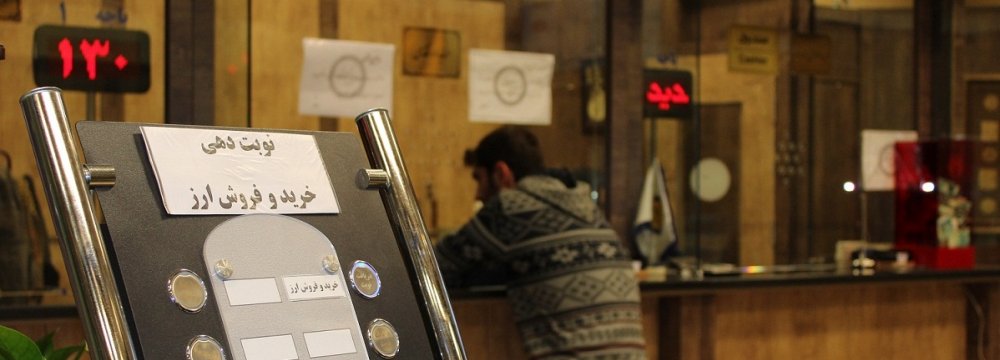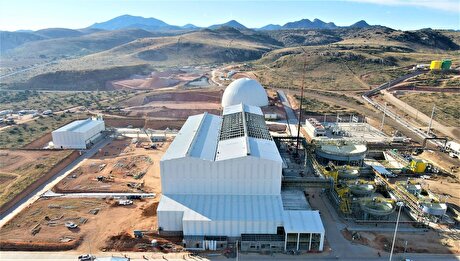
Optimism Over Banks’ Forex Trading

Lotfollah Saeedi, the deputy director of Money and Capital Commission of Tehran Chamber of Commerce, Industries, Mines and Agriculture, added that the potential involvement of the banking system in the unofficial currency market could also improve the market, Banker.ir reported.
“The banking system engaging in the purchase and sale of currency at market rates would entail three positive benefits: it would be a good opportunity for the banking system, exporters would support it and it would improve the market,” he said.
The Central Bank of Iran recently invited businesses to procure their currency requirements from the banking system at market rates. The proposal was received well and is deemed a prelude to the longstanding plan to unify the dual exchange rate regime of the Iranian market.
Back in July, the banking system got the thumps-up from CBI to trade in foreign currencies at the open market rate.
Iran operates two exchange rates, a free market rate and an official rate used for some state transactions, set by the central bank at around 32,300 rials.
The greenback has been rallying for the past few weeks, passing the 40,000-rial to $1 threshold last Wednesday. The rial slipped further in the past days and was quoted in the free market at 41,500 to the dollar on Monday, which is an all-time record low for the rial. On Tuesday, the rial was quoted at 41,000 to the dollar.
In recent months, the central bank has raised the official rate gradually to shrink the gap between the two. It has said it wants to unify the exchange rate to make the economy more efficient and create a level field for private firms competing with state institutions with access to cheaper foreign exchange.

Referring to the proposal, Saeedi maintained that banks’ foray into the open currency market would be positive and could be a prologue for rate unification, but the first thing that must be considered is its implementation and results.
The entry of banking system into the currency market would entail changes for moneychangers.
The TCCIM official notes that this does not mean that they would be removed from the scene altogether, “but the banking system would supplant the bureaux de change to a certain degree”.
Saeedi stressed the importance of implementing the proposal, saying the banking system needs to act fast and maintain flexibility because “the way this plan is implemented will determine its extent of influence”.
A meeting was held at the Ministry of Economic Affairs and Finance to address the recent volatility in the currency market.
Officials with the ministry and the central bank, namely the treasury deputy, Rahmatollah Akrami, and CBI Vice Governor Akbar Komijani, attended the meeting to discuss market conditions and what to do next.
Rate Moderation
Mohsen Bahrami Arz-Aqdas, the head of Trade Commission of Iran Chamber of Commerce, Industries, Mines and Agriculture, said the rial will soon regain ground.
“Considering the formal stance of the government on the issue, forex rates will come down very soon,” he also told ILNA.
Bahrami pointed to recent remarks made by government spokesman, Mohammad Baqer Nobakht, who had stressed that current fluctuations in the currency market are only temporary and a result of higher market demand.
“The current high rate of currencies in the market stems from various reasons, including Christmas travels,” he said. “The [upcoming] change in administration in the US has also impacted the dollar rates.”
The official noted that the election of Donald Trump to the White House has created doubts about Iran’s nuclear accord and “when these issues are resolved, the greenback’s rate against the rial will come down again”.
“In order for the rates to fall in the acceptable domain, the dual foreign exchange rate system must be abolished,” he said, without elaborating on the acceptable domain.
Bahrami claimed that in view of ongoing discussions in the parliament and the private sector, currency exchange rates will be moderated soon, though “prerequisites are needed for rate unification, a part of which is out of the government’s control”.


Trump weighs using $2 billion in CHIPS Act funding for critical minerals

Electra converts debt, launches $30M raise to jumpstart stalled cobalt refinery

Codelco cuts 2025 copper forecast after El Teniente mine collapse

Barrick’s Reko Diq in line for $410M ADB backing

Abcourt readies Sleeping Giant mill to pour first gold since 2014

SQM boosts lithium supply plans as prices flick higher

Nevada army depot to serve as base for first US strategic minerals stockpile

Pan American locks in $2.1B takeover of MAG Silver

Viridis unveils 200Mt initial reserve for Brazil rare earth project

Kyrgyzstan kicks off underground gold mining at Kumtor

Kyrgyzstan kicks off underground gold mining at Kumtor

KoBold Metals granted lithium exploration rights in Congo

Freeport Indonesia to wrap up Gresik plant repairs by early September

Energy Fuels soars on Vulcan Elements partnership

Northern Dynasty sticks to proposal in battle to lift Pebble mine veto

Giustra-backed mining firm teams up with informal miners in Colombia

Critical Metals signs agreement to supply rare earth to US government-funded facility

China extends rare earth controls to imported material

Galan Lithium proceeds with $13M financing for Argentina project

Kyrgyzstan kicks off underground gold mining at Kumtor

Freeport Indonesia to wrap up Gresik plant repairs by early September

Energy Fuels soars on Vulcan Elements partnership

Northern Dynasty sticks to proposal in battle to lift Pebble mine veto

Giustra-backed mining firm teams up with informal miners in Colombia

Critical Metals signs agreement to supply rare earth to US government-funded facility

China extends rare earth controls to imported material

Galan Lithium proceeds with $13M financing for Argentina project

Silver price touches $39 as market weighs rate cut outlook

















